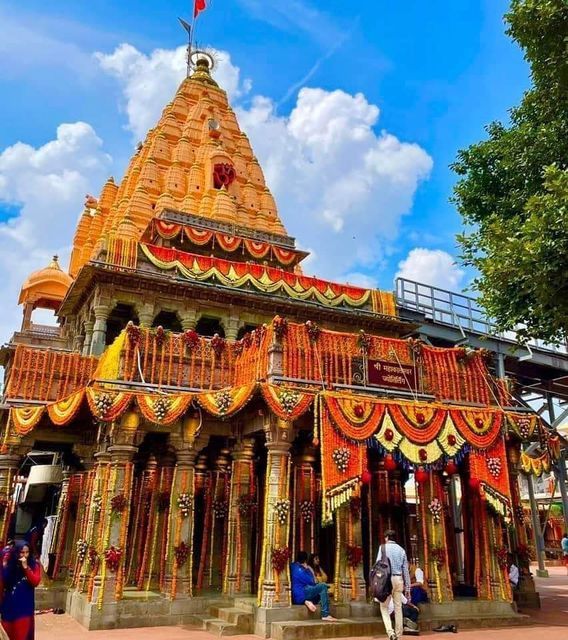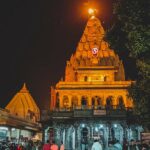Shree Mahakaleshwar: The Divine Heartbeat of Ujjain
Introduction
Shree Mahakaleshwar, the revered temple dedicated to Lord Shiva, stands as a spiritual landmark in Ujjain, Madhya Pradesh. It is one of the twelve Jyotirlingas, making it one of the holiest and most powerful places for Hindus. The temple, with its centuries-old legacy, draws millions of pilgrims and devotees who come to experience its divine energy, rich history, and cultural significance. This article delves into the biography, history, daily life impacts, significance, observance, and the temple’s importance in society, offering an insightful journey through its sacred grounds.
1. The History and Origins of Shree Mahakaleshwar
The temple of Mahakaleshwar is an ancient shrine believed to date back thousands of years. The legend of Mahakaleshwar is intricately tied to the mythology of Lord Shiva. According to ancient texts and myths, Mahakal is the eternal form of Shiva, who is the destroyer and regenerator of the universe. The temple itself is said to be located on the site where Lord Shiva’s presence is most powerful, with the sanctum enshrining the Jyotirlinga, a form of Shiva that is naturally self-manifested.
The history of the Mahakaleshwar temple is woven with stories of kings and emperors who contributed to its restoration and grandeur. It has been mentioned in ancient scriptures, including the Puranas, and has played a central role in the religious life of Ujjain for millennia.
2. The Spiritual Significance of Mahakaleshwar
The Mahakaleshwar Jyotirlinga is one of the twelve most revered shrines of Lord Shiva. Its significance lies in the belief that Lord Shiva in his Mahakal form is the ultimate time keeper who governs the cycle of birth, life, and death. For devotees, a visit to Mahakaleshwar is a way to seek blessings for health, prosperity, and spiritual enlightenment.
The temple is also considered a Siddh Peeth, a place of immense spiritual power where prayers are believed to be granted. Devotees come here not just for the material benefits but also for the ultimate purpose of gaining moksha (liberation) from the cycle of reincarnation.
3. Daily Life at Shree Mahakaleshwar: Rituals and Devotion
A visit to Shree Mahakaleshwar is an immersion into daily practices of devotion and reverence. The temple follows a set routine of rituals, beginning early in the morning with the Mangala Aarti, a special prayer offered to Lord Shiva. Devotees gather at the temple before dawn, offering flowers, fruits, and bel leaves (considered sacred to Shiva).
The Bhasma Aarti, performed in the early hours, is particularly special. The ritual involves offering ash (bhasma) to Lord Mahakaleshwar, symbolizing the impermanence of life and the eternal nature of the soul. It is one of the few temples where this unique ritual is practiced, adding to the temple’s mystique and holiness.
Throughout the day, devotees participate in prayers, chanting of mantras, and offerings, while the priests continue the worship process in the temple’s sanctum. The evening Aarti, known as Shri Mahakaleshwar Jyotirlinga Aarti, is a deeply moving experience, where the entire temple is filled with devotion and divine light.
4. The Significance of Mahakaleshwar in Society
Shree Mahakaleshwar is not only a place of personal devotion but also an important cultural and social hub. The temple serves as the epicenter of Ujjain’s religious identity, attracting pilgrims, tourists, and scholars alike. It contributes significantly to the local economy, with the influx of visitors supporting various industries such as tourism, hospitality, and retail.
Beyond its economic impact, the temple has a powerful societal role. It unites people across the world, irrespective of nationality, caste, or creed, through the shared experience of devotion. The Mahakaleshwar temple also plays an important role in interfaith unity, as it fosters understanding and peace through shared religious experiences.
The temple is also a center for community engagement, with multiple educational and charitable activities. Various religious organizations around the temple offer free meals to the poor, organize medical camps, and run social welfare programs. It is a shining example of how a place of worship can positively influence and uplift society.
5. Festivals and Observances at Mahakaleshwar
Ujjain is alive with energy during the festival of Maha Shivaratri, which celebrates Lord Shiva’s marriage to Goddess Parvati. This is the most significant festival observed at Shree Mahakaleshwar. Thousands of devotees come to the temple to offer prayers, perform pradakshina (circumambulation), and partake in various rituals throughout the night.
Maha Shivaratri at Mahakaleshwar is marked by night-long vigils, chanting of Shiva hymns, and offering milk, water, and bael leaves to the deity. The temple is beautifully lit, and the night culminates in an all-night aarti that echoes with the sounds of devotion.
In addition to Maha Shivaratri, the temple celebrates Navratri, Diwali, and other important Hindu festivals. Each of these occasions is marked with special prayers, processions, and rituals that bring the community together.
6. FAQs About Shree Mahakaleshwar
- What is the Mahakaleshwar Jyotirlinga?
The Mahakaleshwar Jyotirlinga is one of the twelve most sacred shrines dedicated to Lord Shiva. It is believed to have been self-manifested and is considered to be an embodiment of Lord Shiva’s supreme power. - Why is Bhasma Aarti so special at Mahakaleshwar?
The Bhasma Aarti is special because it involves the offering of sacred ash (bhasma) to Lord Shiva, symbolizing the transient nature of material life and the eternal existence of the soul. It is a rare and unique ritual performed only in a few temples across India. - When is the best time to visit Mahakaleshwar Temple?
The best time to visit is during the cooler months, from October to March, but the temple is open throughout the year. Visiting during Maha Shivaratri or Navratri offers a spiritually enriching experience due to the grandeur of the celebrations. - Is Mahakaleshwar Temple only for Hindus?
No, Mahakaleshwar Temple is open to all, and its spiritual significance transcends religious boundaries. People of all faiths are welcome to visit, pray, and seek blessings.
7. Shree Mahakaleshwar’s Role in the Modern World
In today’s fast-paced world, Shree Mahakaleshwar serves as a beacon of hope, peace, and spiritual connection. The temple continues to inspire millions, offering solace and guidance. It helps individuals reconnect with their inner self, their spirituality, and their sense of belonging to something larger than life.
The temple stands as a testament to the enduring power of faith, devotion, and tradition. It reminds us of the timeless presence of the divine and encourages a path of truth, love, and liberation.
Conclusion
Shree Mahakaleshwar is more than just a temple—it is a divine gateway to peace, wisdom, and liberation. Its history, rituals, and spiritual significance make it a destination for all those seeking solace and divine blessings. The temple’s daily rhythms of devotion, cultural impact, and role in society reflect the vibrant and ever-evolving spiritual heritage of Ujjain. Whether you are a devotee, a spiritual seeker, or a visitor exploring India’s rich cultural landscape, Shree Mahakaleshwar offers a transformative experience that connects the material world with the divine.










